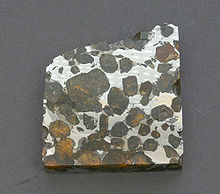Pallasite
Pallasites belong to the group of stone-iron meteorites . For a long time it was assumed that they form in differentiated asteroids in the boundary layer between the nickel - iron core and the silicate mantle. According to a more recent theory, a pallasite is formed closer to the surface when it collides with another celestial body. On impact, molten iron from the core of the projectile mixes with the olive-rich mantle of the mother body. This impact hypothesis has been confirmed experimentally.
Pallasites consist of olivine crystals that are embedded in a matrix of nickel - iron . They were named after the German scholar Peter Simon Pallas , who found the first “Pallasite” during his travels in Siberia near Krasnoyarsk .
The pallasites are divided into three groups due to their different chemical composition:
- Main group pallasites; the most famous representative is the "Pallas iron" found in Siberia in 1749. This important meteorite , now known as “ Krasnoyarsk ”, was examined for the first time by Peter Simon Pallas between 1772 and 1777 and published in 1794 in the pioneering work of Ernst FF Chladni . Other large and impressive pallasite finds were u. a. Made 1807 in Belarus (" Brahin ") and 1951 in Argentina ("Esquel").
- Eagle Station Group
- Pyroxene Pallasite
Each of these groups was formed in its own original body.
In April 2008 Bonhams in New York offered the 420 kg main mass of the Fukang pallasite (found in China in 2000). The estimate was $ 2.75 million, but the meteorite was not sold.
In addition to the meaning given above, pallasite is also a synonym for iron that occurs naturally in meteorites (including stone iron meteorites) .
Individual evidence
- ↑ B. Mason, Meteorites. John Wiley, New York 1962.
- ↑ Meteorites: How are Pallasites formed? Accessed July 31, 2020 .
- ↑ Nicolas P. Walte, Giulio FDSolferino, Gregor J. Golabek, Danielle Silva Souza, Audrey Bouvier: Two-stage formation of pallasites and the evolution of their parent bodies revealed by deformation experiments . In: Earth and Planetary Science Letters . Vol. 546. Elsevier BV, ISSN 0012-821X , 116419.
- ^ Fukang Pallasite Meteorite Auction by Bonhams , accessed on April 4, 2016
- ↑ Stefan Weiß: The large Lapis mineral directory . 5th edition. Christian Weise Verlag, Munich 2008, ISBN 978-3-921656-70-9 , p. 196 .


